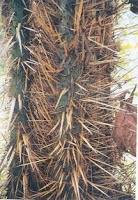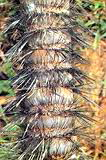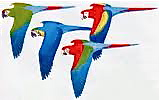Once you begin la dieta, once you drink ayahuasca, once you begin to form relations of confianza with the healing plants, the world becomes a more dangerous place.
Sorcerers resentful of your presumption will shoot magical pathogenic darts into your body, or send fierce animals to attack you, or fill your body with scorpions and razor blades — especially while you are still a beginner, before you gain your full powers. Even experienced shamans under the influence of ayahuasca are vulnerable to attack by envious or vengeful sorcerers. Poet César Calvo says that drinking ayahuasca makes one into “a crystal exposed to all the spirits, to the evil ones and the true ones that inhabit the air.” Such transparency is perilous.
This is also true when a shaman is drunk or asleep. Elder shamans may sleep surrounded by apprentices, to be protected from such attacks. Very often these struggles take place in dreams; shamans who lose this dream battle may never wake up. My teacher doña María Tuesta was attacked this way during her sleep, when magic darts were shot deep into her throat and chest, so that she could not sing her protective songs.
So there is a need for constant protection. Anything that protects from an attack — animal protectors, magical birds, spiny palms, fierce Indians, suits of armor, fighter jets — is called an arcana, probably from the Quechua arkay, block, bar, rather than from the Latin arcana, secrets. And that is why, at the start of every healing ceremony, my teacher don Roberto Acho, with greater or less elaboration, constructs a wall of arcana around the site — “a thousand feet high,” he says, “and a thousand feet below the earth” — to protect himself, and his students, and all who are in attendance.
 |
| Spines of the chambira (Astrocaryum chambira) |
A shaman has many means of protection from the intrusion of pathogenic objects projected by enemy sorcerers. First among these is the shaman’s mariri, the rarified phlegm that rises from the shaman’s chest into the throat, nourished by ayahuasca and mapacho, and which serves to absorb the darts, the sickness, the phlegmosity, the scorpions and toads that the shaman sucks from the patient’s body. whose power is then assimilated by the shaman, or projected back upon the one who sent them.
Similarly, the strong sweet smells of tobacco, camphor, cologne, mouthwash, and disinfectant protect the shaman and the shaman’s patients, since they attract the healing and protective spirits and keep away the pathogenic projectiles, the animal surrogates, the detestable breath or tobacco smoke of the sorcerer. This is the protection the shaman gives to patients, after extracting a dart, by blowing tobacco smoke over and into their bodies. And a shaman must constantly maintain these defenses. Don Francisco Montes Shuña says that a shaman must blow tobacco smoke in three directions — front, right, and left — every four hours, even during the night. At the very least, the shaman must have songs and tobacco ready to be deployed in case of a sudden attack.
 |
| Spines of the pijuayo (Bactris macana) |
Shamans also acquire protective spirits, often powerful birds or animals. The animals and other spirits that protect the healer are the same as those that carry out the destructive will of the sorcerer. Shamans accumulate a large number of these protectors, who are called in at the beginning of the ayahuasca ceremony, but who also accompany the shaman, ready to leap into action if an attack is imminent. All these protective spirits are summoned or activated by singing their icaros, called icaros arcanas; the spirits may be given by one’s teacher, or appear to one in an ayahuasca vision or a dream. Some may be kept in the shaman’s chest, embedded in the magical phlegm.
Particularly valued as protector plants — because often used in sorcery — are the spiny or thorny palms, whose spines are used by brujos as their virotes, magic darts. Of these palms, used as both weapons and arcana, doña María and don Roberto refer frequently to four — the chambira (Astrocaryum chambira), huicungo (Astrocaryum murumuru), pijuayo (Bactris macana), and huiririma (Astrocaryum jauarii) palms. Other spiny palms invoked for sorcery and protection — and portrayed in a painting by Pablo Amaringo — include the inchaui (Syagrus tessmannii), pona (Socratea exorrhiza), inayuga (Maximiliana spp.), and huasaí (Euterpe spp.). The term chonta is applied, somewhat indiscriminately, to spiny palms in the genera Astrocaryum, Euterpe, and Bactris.
 |
| Guacamayos, macaws, doña María’s fierce protectors |
A sorcerer can send animals as spies, and especially can talk to birds in their own language; that is why a healer must know their language as well. Don Rómulo Magin, for example, is fluent in the language of búhos, owls, who are powerful sorcerer birds; their language, I am told, sounds like this: oootutututu kakakaka hahahahaha.
The sorcerer talks to the bird, and puts his own soul into the bird; then the bird carries the sorcery to the victim, shooting darts from its beak. When sorcery is conveyed by one of these birds, I was told, the victim’s hair falls out, the skin roughens, and the victim begins to look like the bird. Such an attack is particularly dangerous: even if a healer succeeds in sucking out the darts projected by the bird, the sorcery can send the bird more darts to project into the victim, and thus keep the victim continually sick. Thus, one should be careful any time one sees one of the birds associated with such sorcery, for one might well be the target of a magical attack.
The animal ally of a sorcerer can also be the ally of a healer. Such birds are often predators, such as gavilán, hawks (Accipitridae), and búho, owls (Strigidae), or are notable for plumage or particularly piercing or unusual cries — for example, the manshaco, wood stork (Mycteria americana), cushuri, cormorant (Phalacrocorax spp.), camungo, horned screamer (Anhima cornuta), jabirú, jabiru (Jabiru mycteria), sharara, aninga (Anhinga anhinga), guacamayo, macaw (Ara spp.), trompetero, trumpeter (Psophia spp.), or chajá, crested screamer (Chauna torquata).
 |
| Birds of sorcery (left to right: camungo, manshaco, jabirú, cushuri) |
Shamans acquire a variety of animals as protectors. Don Roberto said that he had two protectors of the earth — the boa negra, black boa, and otorongo, tawny jaguar; and two of the water — the yanapuma, black jaguar, and the yacuruna, the water people, magical and sexually seductive spirits who live in great cities below the water. At my coronación, initiation, don Rober gave me, along with his phlegm, two protective animals, one each of earth and water — two jaguars, a tawny and a black.
Usually one’s first protective animals stay with one for life, with additional protectors added over time to one’s armamentarium as one progresses. When I first met doña María, she asked me whether, as a norteamericano, I had ever seen a bear. She had seen, she said, a polar bear — or at least an oso blanco — in a movie on television. In fact, doña María had two bears, one black and one white, as protector animals. She told me that the bear had become her protector before she had ever seen it on television.
One of doña María’s first protective animals was the aquila, in this case probably the Andean condor, rather than any of the various Peruvian species of eagles. She acquired her protective animals when she first drank ayahuasca; the animals were, she said, like “soldiers of ayahuasca.” These protectors grow in power as one smokes mapacho and drinks ayahuasca, tobacco infusions, and agua de florida. Her protectors always accompanied her; she could see them there with us while we talked.
Her protectors thus included wolves and two bears, black and white, and two forms of boa constrictor — the boa negra, black boa, and boa amarilla, yellow boa. Her protectors also included several types of bird — condors, owls, timelitos (an unidentified small shore bird), and especially guacamayos, macaws. In one of her earliest ayahuasca visions, two macaws had come and sat on doña María’s shoulders, and spoke to her in the Inca language; from that time on, she knew, these macaws would be her protectors.
So, whenever doña María started to work, she told me, the macaws came and landed on her head and shoulders, to protect her. The animals “take care of me spiritually.” If someone was about to attack her, the animals would preemptively strike on her behalf — the attacker crushed by her boas and clawed by her ferocious birds. I once asked doña María if this was consistent with pura blancura, her pure white path. She gave me one of her looks. “We are gentle people,” she told me. “But sometimes we show our claws.”
These animal protectors can form complex protective barriers. Don Celso Rójas, when dealing with sorcery, has, among other animals, a condorpishcu, a little white bird with a red neck, flying about his head to warn him of an attack; a lion on his right shoulder, a black jaguar on his left, and an elephant before him; a shushupi, bushmaster, around his neck; and a school of piranha.
Protectors may take human form as well. The protectors of don Agustin Rivas are Indians, armed with bows, arrows, and darts, wearing feathered crowns, with eyes in the back of their heads. They are, he says, cruel, vengeful, and very protective; even though he himself has no intentions of harming anyone, his protectors punish with sickness or death anyone who threatens or hurts him. Don Emilio Andrade has a large Brazilian black man armed with daggers, who follows his enemies and locks them into dark tunnels in the Andes.
Indeed, protectors may be angels with swords, tree spirits with guns, a warplane that bombs and destroys the shaman’s enemies. Luis Panduro Vasquez has songs of protection he calls icaro de electricidad, icaro de candela, icaro cubrir con la manta, icaro como un sombrero de piedra — icaros, respectively, of electricity, of fire, to cover with a blanket, and like a hat of stone. Among doña María’s protectors were, of course, Jesucristo, Jesus Christ, and Hermana Virgen, the Virgin Mary.
There is a distinction made among various sorts of cuerpo, body. A cuerpo dañado, harmed body, is a body attacked by sickness and sorcery; a cuerpo sencillo, ordinary body, is one currently unaffected by sickness but without protection; a cuerpo preparado, prepared body, is one protected by plants, and especially by mapacho, tobacco smoke, blown over the body and into the body through the top of the head; and, strongest of all, a cuerpo sellado, sealed body, sometimes called a cuerpo cerrado, closed body, is one protected by an arcana, that prevents any penetration, that resists attack by sorcery.

- Previous Post: A Death in the Jungle
- Next Post: What Are Spirits?
- More Articles Related to: Sacred Plants, Shamanism



Hello Steve.
I just got an Audio CD of Luis Panduro Vasquez. I wanted to know if there will be any benefit by meditating while listening to the songs?
Thanks
Sid
Hi Sid, I just saw your question… I know its long ago you’ve been asking but maybe you still want to know? I just got the songs from Luis Panduro Vasquez and I have been joining many of his ceremonies in Peru just a month ago… So I know that his icaros are very powerful and have got a meaning and they are supporting processes of healing… Sure they are more strong when you´re in a setting of a ceremony and in connection with drinking the ayahuasca vine… but still when you´ll get into a meditating state and just do your own journey through yourself with the songs there will be always something happening… an insight a certain feeling a picture.. it can be anything… it depends always on your intention… if it is healing you’re calling already the spirits to help you by sending out your intention.. and the icaros will support it in the same way… best wishes Iris from Berlin..
I don’t know. What does your teacher say?
Hi Steve,
I have a question that has puzzled me for some time about a shamans/practitioners relationship with plant spirits. I have read that sometimes negative spirits can take up residence in the body of people and feed off of negative emotions and their energy. This would suggest to me that spirits need some form of nourishment to survive.
In reading other articles I understand that an Ayahuasca shaman often encourages ‘good spirits’ to take up residence in both himself and his clients to aid in protection and guidance. The question is what is in it for the spirit who takes up residence in one’s body? What is the general view of this in shamanic cultures? It seems surprising to me that this subject is not discussed more, after all you never get something for free and perhaps these plant spirits change or drain ones energy in some way?
Regards,
Ben
Hi Steve
I have the same question as above. Connection with one of such protectors was offered to me, yet I did not feel at ease with getting it/arcana. While it make sense in the world of amazon healers/sourceres wars, it was not clear how all of this would fit in in the grand scheme of things with Creator at the top (my world).
BTW, it was great to see yout ethymological explanation on Arcana.
Thanks